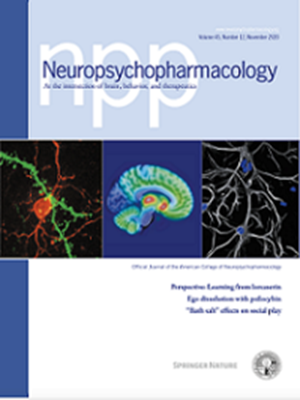皮内针刺治疗重度抑郁症的疗效及脑机制:一项多中心随机对照试验。
IF 6.6
1区 医学
Q1 NEUROSCIENCES
引用次数: 0
摘要
重度抑郁障碍(MDD)需要新的组合疗法或替代疗法。皮内针灸(IA)前景看好,但其疗效、安全性和机制仍需进一步研究。我们的随机对照试验于2022年11月至2024年1月在3个中心进行,共纳入120名中重度MDD患者,分为选择性5-羟色胺再摄取抑制剂(SSRIs)组、SSRIs加假IA(SSRIs + SIA)组和SSRIs加活性IA(SSRIs + AIA)组。针灸组在神门(HT7)、内关(PC6)、三阴交(SP6)和太冲(LR3)接受为期 6 周的 10 次针灸治疗,然后进行为期 4 周的随访。主要结果是第 6 周时汉密尔顿抑郁量表-17(HAMD-17)评分的变化。此外,健康对照组(HCs)和 MDD 患者还接受了磁共振成像(MRI)扫描,以进行功能连接(FC)分析。治疗 6 周后,SSRIs + AIA 组的 HAMD-17 评分降低幅度大于 SSRIs + SIA 组(MD,-4.9 [CI,-7.6 至 -2.2],P<0.05)。本文章由计算机程序翻译,如有差异,请以英文原文为准。

The efficacy and cerebral mechanism of intradermal acupuncture for major depressive disorder: a multicenter randomized controlled trial
New combinations or alternative therapies for major depressive disorder (MDD) are necessary. Intradermal acupuncture (IA) shows promise but requires further investigation regarding its efficacy, safety, and mechanisms. Conducted across 3 centers from November 2022 to January 2024, our randomized controlled trial included 120 participants with moderate to severe MDD, divided into the selective serotonin reuptake inhibitors (SSRIs), SSRIs plus sham IA (SSRIs + SIA), and SSRIs plus active IA (SSRIs + AIA) groups. Acupuncture groups received 10 sessions over 6 weeks at Shenmen (HT7), Neiguan (PC6), Sanyinjiao (SP6) and Taichong (LR3) bilaterally, followed by a 4-week follow-up. The primary outcome was changes in Hamilton Depression Rating Scale-17 (HAMD-17) scores at week 6. Furthermore, healthy controls (HCs) and MDD patients underwent magnetic resonance imaging (MRI) scans for functional connectivity (FC) analysis. After 6 weeks of treatment, the SSRIs + AIA group showed a greater reduction in HAMD-17 score than the SSRIs + SIA group (MD, −4.9 [CI, −7.6 to −2.2], P < 0.001) and SSRIs group (MD, −5.1 [CI, −7.8 to −2.3], P < 0.001). No serious adverse events occurred. SSRIs + AIA resulted in lower incidences of palpitations (vs.SSRIs + SIA: OR, 0.1% [CI, 0.0–1.0%]; vs. SSRIs: OR, 0.1% [CI, 0.0–0.7%]; P < 0.05), somnolence (vs.SSRIs + SIA: OR, 0.1% [CI, 0.0–0.9%]; vs.SSRIs: OR, 0.1% [CI, 0.0–0.7%]; P < 0.05), and nausea (vs.SSRIs + SIA: OR, 0.1% [CI, 0.0–1.0%]; vs. SSRIs: OR, 0.1% [CI, 0.0–0.9%]; P < 0.05). MDD patients showed abnormal FCs, and IA enhanced FCs between striatum and frontal_inf_tri, and striatum and cerebellum in the MRI study. Overall, IA as adjunctive therapy provides clinical efficacy and safety for MDD, and it may exert antidepressant effects by modulating striatal FCs.
求助全文
通过发布文献求助,成功后即可免费获取论文全文。
去求助
来源期刊

Neuropsychopharmacology
医学-精神病学
CiteScore
15.00
自引率
2.60%
发文量
240
审稿时长
2 months
期刊介绍:
Neuropsychopharmacology is a reputable international scientific journal that serves as the official publication of the American College of Neuropsychopharmacology (ACNP). The journal's primary focus is on research that enhances our knowledge of the brain and behavior, with a particular emphasis on the molecular, cellular, physiological, and psychological aspects of substances that affect the central nervous system (CNS). It also aims to identify new molecular targets for the development of future drugs.
The journal prioritizes original research reports, but it also welcomes mini-reviews and perspectives, which are often solicited by the editorial office. These types of articles provide valuable insights and syntheses of current research trends and future directions in the field of neuroscience and pharmacology.
 求助内容:
求助内容: 应助结果提醒方式:
应助结果提醒方式:


